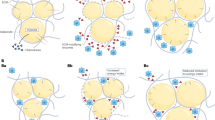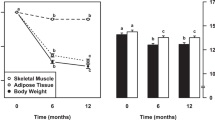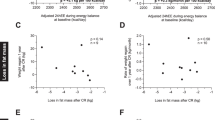Abstract
The decrease in energy expenditure that occurs during weight loss is a process that attenuates over time the impact of a restrictive diet on energy balance up to a point beyond which no further weight loss seems to be possible. For some health professionals, such a diminished energy expenditure is the normal consequence of a progressive decrease in the motivation to exercise over the course of a weight-reducing program. Another explanation of decreased energy needs during weight loss is the decrease in body energy stores (that is, fat mass and muscle mass) and its related obligatory costs of living. Many studies have also documented the existence of adaptive thermogenesis in the context of weight loss, which represents a greater-than-predicted decrease in energy expenditure. In this paper, we pursue the analysis of this phenomenon by demonstrating that an adaptive decrease in thermogenesis can have a major role in the occurrence of resistance to further lose fat in weight-reduced obese individuals. Evidence is also presented to support the idea of greater hunger sensations in individuals displaying more pronounced thermogenic changes. Finally, as the decrease in thermogenesis persists over time, it is also likely associated with a greater predisposition to body-weight regain after weight loss. Globally, these observations suggest that the adaptive reduction in thermogenesis that accompanies a prolonged negative energy balance is a major determinant of the ability to spontaneously lose body fat.
This is a preview of subscription content, access via your institution
Access options
Subscribe to this journal
Receive 12 print issues and online access
$259.00 per year
only $21.58 per issue
Buy this article
- Purchase on Springer Link
- Instant access to full article PDF
Prices may be subject to local taxes which are calculated during checkout





Similar content being viewed by others
References
Tremblay A, Major GC, Doucet E, Trayhurn P, Astrup A . Role of adaptive thermogenesis in unsuccessful weight-loss intervention. Future Lipidol 2007; 2: 651–658.
Major GC, Doucet E, Trayhurn P, Astrup A, Tremblay A . Clinical significance of adaptive thermogenesis. Int J Obes (Lond) 2007; 31: 204–212.
Leibel RL, Rosenbaum M, Hirsch J . Changes in energy expenditure resulting from altered body weight. N Engl J Med 1995; 332: 621–628.
Doucet E, Imbeault P, St-Pierre S, Almeras N, Mauriege P, Richard D et al. Appetite after weight loss by energy restriction and a low-fat diet-exercise follow-up. Int J Obes 2000a; 24: 906–914.
Doucet E, Pierre S, Almeras N, Mauriege P, Richard D, Tremblay A . Changes in energy expenditure and substrate oxidation resulting from weight loss in obese men and women: is there an important contribution of leptin? J Clin Endocrinol Metab 2000b; 85: 1550–1556.
Doucet E, Imbeault P, St-Pierre S, Almeras N, Mauriege P, Despres JP et al. Greater than predicted decrease in energy expenditure during exercise after body weight loss in obese men. Clin Sci (Lond) 2003; 105: 89–95.
Wijers SL, Saris WH, van Marken Lichtenbelt WD . Individual thermogenic responses to mild cold and overfeeding are closely related. J Clin Endocrinol Metab 2007; 92: 4299–4305.
Alfonzo-Gonzalez G, Doucet E, Almeras N, Bouchard C, Tremblay A . Estimation of daily energy needs with the FAO/WHO/UNU 1985 procedures in adults: comparison to whole-body indirect calorimetry measurements. Eur J Clin Nutr 2004; 58: 1125–1131.
Rothwell NJ, Stock MJ . A role for brown adipose tissue in diet-induced thermogenesis. Nature 1979; 281: 31–35.
van Marken Lichtenbelt WD, Vanhommerig JW, Smulders NM, Drossaerts JM, Kemerink GJ, Bouvy ND et al. Cold-activated brown adipose tissue in healthy men. N Engl J Med 2009; 360: 1500–1508.
Cypess AM, Lehman S, Williams G, Tal I, Rodman D, Goldfine AB et al. Identification and importance of brown adipose tissue in adult humans. N Engl J Med 2009; 360: 1509–1517.
Virtanen KA, Lidell ME, Orava J, Heglind M, Westergren R, Niemi T et al. Functional brown adipose tissue in healthy adults. N Engl J Med 2009; 360: 1518–1525.
Chernogubova E, Cannon B, Bengtsson T . Norepinephrine increases glucose transport in brown adipocytes via beta3-adrenoceptors through a cAMP, PKA, and PI3-kinase-dependent pathway stimulating conventional and novel PKCs. Endocrinology 2004; 145: 269–280.
Marette A, Bukowiecki LJ . Noradrenaline stimulates glucose transport in rat brown adipocytes by activating thermogenesis. Evidence that fatty acid activation of mitochondrial respiration enhances glucose transport. Biochem J 1991; 277: 119–124.
Nedergaard J, Bengtsson T, Cannon B . Unexpected evidence for active brown adipose tissue in adult humans. Am J Physiol Endocrinol Metab 2007; 293: E444–E452.
Yoneshiro T, Aita S, Matsushita M, Kameya T, Nakada K, Kawai Y et al. Brown adipose tissue, whole-body energy expenditure, and thermogenesis in healthy adult men. Obesity (Silver Spring) 2011; 19: 13–16.
Ouellet V, Labbe SM, Blondin DP, Phoenix S, Guerin B, Haman F et al. Brown adipose tissue oxidative metabolism contributes to energy expenditure during acute cold exposure in humans. J Clin Invest 2012; 122: 545–552.
Rosenbaum M, Hirsch J, Murphy E, Leibel RL . Effects of changes in body weight on carbohydrate metabolism, catecholamine excretion, and thyroid function. Am J Clin Nutr 2000; 71: 1421–1432.
Rosenbaum M, Goldsmith R, Bloomfield D, Magnano A, Weimer L, Heymsfield S et al. Low-dose leptin reverses skeletal muscle, autonomic, and neuroendocrine adaptations to maintenance of reduced weight. J Clin Invest 2005; 115: 3579–3586.
Rosenbaum M, Murphy EM, Heymsfield SB, Matthews DE, Leibel RL . Low dose leptin administration reverses effects of sustained weight-reduction on energy expenditure and circulating concentrations of thyroid hormones. J Clin Endocrinol Metab 2002; 87: 2391–2394.
Collins WT, Capen CC, Kasza L, Carter C, Dailey RE . Effect of polychlorinated biphenyl (PCB) on the thyroid gland of rats. Ultrastructural and biochemical investigations. Am J Pathol 1977; 89: 119–136.
Bastomsky CH . Goitres in rats fed polychlorinated biphenyls. Can J Physiol Pharmacol 1977; 55: 288–292.
Byrne JJ, Carbone JP, Hanson EA . Hypothyroidism and abnormalities in the kinetics of thyroid hormone metabolism in rats treated chronically with polychlorinated biphenyl and polybrominated biphenyl. Endocrinology 1987; 121: 520–527.
Hagmar L, Rylander L, Dyremark E, Klasson-Wehler E, Erfurth EM . Plasma concentrations of persistent organochlorines in relation to thyrotropin and thyroid hormone levels in women. Int Arch Occup Environ Health 2001; 74: 184–188.
Sala M, Sunyer J, Herrero C, To-Figueras J, Grimalt J . Association between serum concentrations of hexachlorobenzene and polychlorobiphenyls with thyroid hormone and liver enzymes in a sample of the general population. Occup Environ Med 2001; 58: 172–177.
Van Birgelen AP, Smit EA, Kampen IM, Groeneveld CN, Fase KM, Van der Kolk J et al. Subchronic effects of 2,3,7,8-TCDD or PCBs on thyroid hormone metabolism: use in risk assessment. Eur J Pharmacol 1995; 293: 77–85.
Barter RA, Klaassen CD . UDP-glucuronosyltransferase inducers reduce thyroid hormone levels in rats by an extrathyroidal mechanism. Toxicol Appl Pharmacol 1992; 113: 36–42.
Imbeault P, Tremblay A, Simoneau JA, Joanisse DR . Weight loss-induced rise in plasma pollutant is associated with reduced skeletal muscle oxidative capacity. Am J Physiol Endocrinol Metab 2002; 282: E574–E579.
Narasimhan TR, Kim HL, Safe SH . Effects of hydroxylated polychlorinated biphenyls on mouse liver mitochondrial oxidative phosphorylation. J Biochem Toxicol 1991; 6: 229–236.
Pardini RS . Polychlorinated biphenyls (PCB): effect on mitochondrial enzyme systems. Bull Environ Contam Toxicol 1971; 6: 539–545.
Pelletier C, Doucet E, Imbeault P, Tremblay A . Associations between weight loss-induced changes in plasma organochlorine concentrations, serum T(3) concentration, and resting metabolic rate. Toxicol Sci 2002; 67: 46–51.
Tremblay A, Pelletier C, Doucet E, Imbeault P . Thermogenesis and weight loss in obese individuals: a primary association with organochlorine pollution. Int J Obes Relat Metab Disord 2004; 28: 936–939.
Bouchard C, Tremblay A, Despres JP, Nadeau A, Lupien PJ, Theriault G et al. The response to long-term overfeeding in identical twins. N Engl J Med 1990; 322: 1477–1482.
Poehlman ET, Despres JP, Marcotte M, Tremblay A, Theriault G, Bouchard C . Genotype dependency of adaptation in adipose tissue metabolism after short-term overfeeding. Am J Physiol 1986a; 250: E480–E485.
Poehlman ET, Tremblay A, Fontaine E, Despres JP, Nadeau A, Dussault J et al. Genotype dependency of the thermic effect of a meal and associated hormonal changes following short-term overfeeding. Metabolism 1986b; 35: 30–36.
Bouchard C, Tremblay A, Despres JP, Theriault G, Nadeau A, Lupien PJ et al. The response to exercise with constant energy intake in identical twins. Obes Res 1994; 2: 400–410.
Tremblay A, Poehlman ET, Nadeau A, Dussault J, Bouchard C . Heredity and overfeeding-induced changes in submaximal exercise VO2. J Appl Physiol 1987; 62: 539–544.
Tremblay A, Poehlman ET, Despres JP, Theriault G, Danforth E, Bouchard C . Endurance training with constant energy intake in identical twins: changes over time in energy expenditure and related hormones. Metabolism 1997; 46: 499–503.
Lee HY, Park JH, Seok SH, Baek MW, Kim DJ, Lee KE et al. Human originated bacteria, Lactobacillus rhamnosus PL60, produce conjugated linoleic acid and show anti-obesity effects in diet-induced obese mice. Biochim Biophys Acta 2006; 1761: 736–744.
Gnaiger E . Heat dissipation and energetic efficiency in animal anoxibiosis: economy contra power. J Exp Zoo 1983; 228: 471–490.
Shi H, Dirienzo D, Zemel MB . Effects of dietary calcium on adipocyte lipid metabolism and body weight regulation in energy-restricted aP2-agouti transgenic mice. Faseb J 2001; 15: 291–293.
Zemel MB, Shi H, Greer B, Dirienzo D, Zemel PC . Regulation of adiposity by dietary calcium. Faseb J 2000; 14: 1132–1138.
Ping-Delfos WC, Soares M . Diet induced thermogenesis, fat oxidation and food intake following sequential meals: influence of calcium and vitamin D. Clin Nutr 2011; 30: 376–383.
St-Onge MP, Claps N, Heshka S, Heymsfield SB, Kosteli A . Greater resting energy expenditure and lower respiratory quotient after 1 week of supplementation with milk relative to supplementation with a sugar-only beverage in children. Metabolism 2007; 56: 1699–1707.
Major GC, Alarie FP, Dore J, Tremblay A . Calcium plus vitamin D supplementation and fat mass loss in female very low-calcium consumers: potential link with a calcium-specific appetite control. Br J Nutr 2009; 101: 659–663.
Teegarden D, White KM, Lyle RM, Zemel MB, Van Loan MD, Matkovic V et al. Calcium and dairy product modulation of lipid utilization and energy expenditure. Obesity (Silver Spring) 2008; 16: 1566–1572.
Atkinson RL, Dhurandhar NV, Allison DB, Bowen RL, Israel BA, Albu JB et al. Human adenovirus-36 is associated with increased body weight and paradoxical reduction of serum lipids. Int J Obes (Lond) 2005; 29: 281–286.
Atkinson RL, Lee I, Shin HJ, He J . Human adenovirus-36 antibody status is associated with obesity in children. Int J Pediatr Obes 2010; 5: 157–160.
Chaput JP, Despres JP, Bouchard C, Tremblay A . The association between sleep duration and weight gain in adults: a 6-year prospective study from the Quebec Family Study. Sleep 2008; 31: 517–523.
Chaput JP, Leblanc C, Perusse L, Despres JP, Bouchard C, Tremblay A . Risk factors for adult overweight and obesity in the Quebec Family Study: have we been barking up the wrong tree? Obesity (Silver Spring) 2009; 17: 1964–1970.
Koban M, Swinson KL . Chronic REM-sleep deprivation of rats elevates metabolic rate and increases UCP1 gene expression in brown adipose tissue. Am J Physiol Endocrinol Metab 2005; 289: E68–E74.
Cirelli C, Tononi G . Uncoupling proteins and sleep deprivation. Arch Ital Biol 2004; 142: 541–549.
Brondel L, Romer MA, Nougues PM, Touyarou P, Davenne D . Acute partial sleep deprivation increases food intake in healthy men. Am J Clin Nutr 2010; 91: 1550–1559.
Nedeltcheva AV, Kilkus JM, Imperial J, Schoeller DA, Penev PD . Insufficient sleep undermines dietary efforts to reduce adiposity. Ann Intern Med 2010; 153: 435–441.
McGuire MT, Wing RR, Klem ML, Seagle HM, Hill JO . Long-term maintenance of weight loss: do people who lose weight through various weight loss methods use different behaviors to maintain their weight? Int J Obes 1998; 22: 572–577.
Rosenbaum M, Leibel RL . Adaptive thermogenesis in humans. Int J Obes (Lond) 2010; 34: S47–S55.
Doucet E, St-Pierre S, Alméras N, Després J-P, Bouchard C, Tremblay A . Evidence for the existence of adaptive thermogenesis during weight loss. Br J Nutr 2001; 85: 715–723.
Tremblay A, Chaput JP . Adaptive reduction in thermogenesis and resistance to lose fat in obese men. Br J Nutr 2009; 102: 488–492.
Doucet E, Cameron J . Appetite control after weight loss: what is the role of bloodborne peptides? Appl Physiol Nutr Metab 2007; 32: 523–532.
Doucet E, Pomerleau M, Harper ME . Fasting and postprandial total ghrelin remain unchanged after short-term energy restriction. J Clin Endocrinol Metab 2004; 89: 1727–1732.
Pasman WJ, Saris WH, Westerterp-Plantenga MS . Predictors of weight maintenance. Obes Res 1999; 7: 43–50.
McGuire MT, Wing RR, Klem ML, Lang W, Hill JO . What predicts weight regain in a group of successful weight losers? J Consult Clin Psychol 1999; 67: 177–185.
Gilbert JA, Drapeau V, Astrup A, Tremblay A . Relationship between diet-induced changes in body fat and appetite sensations in women. Appetite 2009; 52: 809–812.
Bray GA . Effect of caloric restriction on energy expenditure in obese patients. Lancet 1969; 2: 397–398.
Schwartz A, Doucet E . Relative changes in resting energy expenditure during weight loss: a systematic review. Obes Rev 2010; 11: 531–547.
Miller DS, Parsonage S . Resistance to slimming: adaptation or illusion? Lancet 1975; 1: 773–775.
Ravussin E, Lillioja S, Knowler WC, Christin L, Freymond D, Abbott WGH et al. Reduced rate of energy expenditure as a risk factor for body-weight gain. N Engl J Med 1988; 318: 467–472.
Cameron JD, Goldfield GS, Cyr MJ, Doucet E . The effects of prolonged caloric restriction leading to weight-loss on food hedonics and reinforcement. Physiol Behav 2008; 94: 474–480.
Keys A, Brozek J, Henschel A, Mickelsen O, Taylor HL . The Biology of Human Starvation. The University of Minnesota Press: Minneapolis, 1950.
Dulloo AG, Jacquet J . Adaptive reduction in basal metabolic rate in response to food deprivation in humans: a role for feedback signals from fat stores. Am J Clin Nutr 1998; 68: 599–606.
Astrup A, Gotzsche PC, van de Werken K, Ranneries C, Toubro S, Raben A et al. Meta-analysis of resting metabolic rate in formerly obese subjects. Am J Clin Nutr 1999; 69: 1117–1122.
Rosenbaum M, Hirsch J, Gallagher DA, Leibel RL . Long-term persistence of adaptive thermogenesis in subjects who have maintained a reduced body weight. Am J Clin Nutr 2008a; 88: 906–912.
Westerterp-Plantenga MS, Saris WH, Hukshorn CJ, Campfield LA . Effects of weekly administration of pegylated recombinant human OB protein on appetite profile and energy metabolism in obese men. Am J Clin Nutr 2001; 74: 426–434.
Rosenbaum M, Sy M, Pavlovich K, Leibel RL, Hirsch J . Leptin reverses weight loss-induced changes in regional neural activity responses to visual food stimuli. J Clin Invest 2008b; 118: 2583–2591.
Acknowledgements
AT is partly funded by the Canada Research Chair in Environment and Energy Balance. JPC holds a Junior Research Chair in Healthy Active Living and Obesity Research. ED is a recipient of a CIHR/Merck-Frosst New Investigator Award, CFI/OIT New Opportunities Award and of an Early Researcher Award.
Author information
Authors and Affiliations
Corresponding author
Ethics declarations
Competing interests
The authors declare no conflict of interest.
Rights and permissions
About this article
Cite this article
Tremblay, A., Royer, MM., Chaput, JP. et al. Adaptive thermogenesis can make a difference in the ability of obese individuals to lose body weight. Int J Obes 37, 759–764 (2013). https://doi.org/10.1038/ijo.2012.124
Received:
Revised:
Accepted:
Published:
Issue Date:
DOI: https://doi.org/10.1038/ijo.2012.124
Keywords
This article is cited by
-
GDF15 promotes weight loss by enhancing energy expenditure in muscle
Nature (2023)
-
Effects of a 4-month active weight loss phase followed by weight loss maintenance on adaptive thermogenesis in resting energy expenditure in former elite athletes
European Journal of Nutrition (2022)
-
Effects of intermittent versus continuous dieting on weight and body composition in obese and overweight people: a systematic review and meta-analysis of randomized controlled trials
International Journal of Obesity (2019)
-
Cognitive and autonomic determinants of energy homeostasis in obesity
Nature Reviews Endocrinology (2015)
-
Adaptive Thermogenesis in Resistance to Obesity Therapies: Issues in Quantifying Thrifty Energy Expenditure Phenotypes in Humans
Current Obesity Reports (2015)



